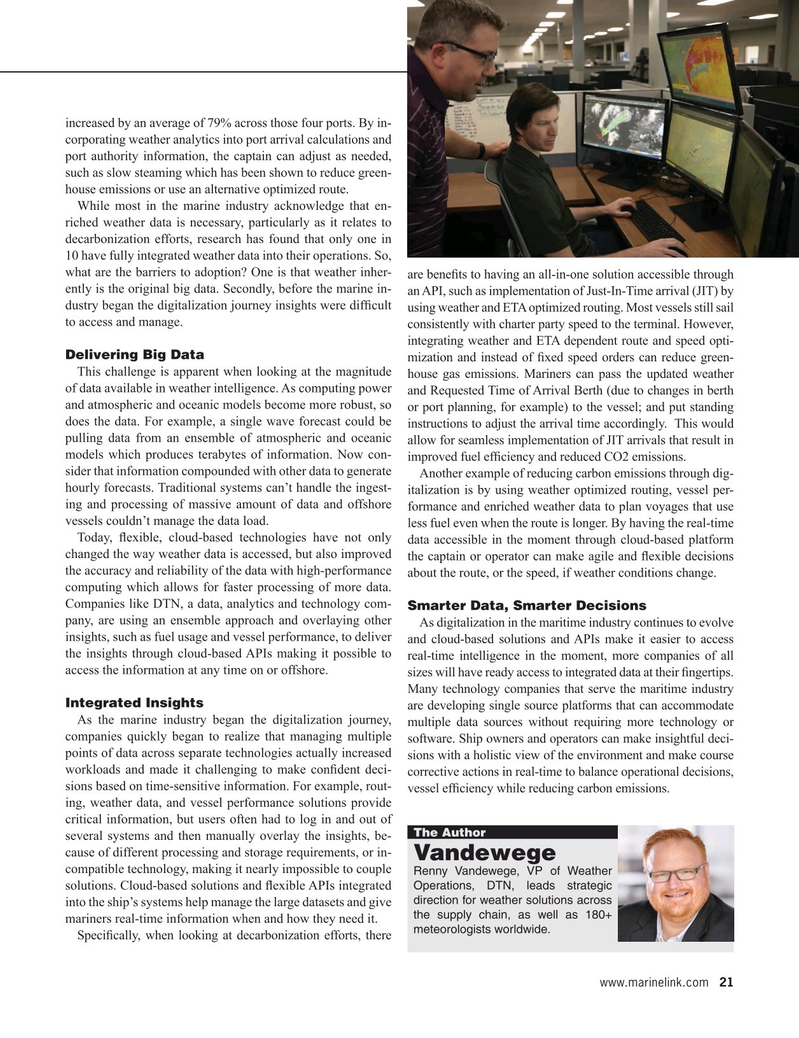
Page 21: of Maritime Reporter Magazine (June 2022)
USCG Fleet Modernization Annual
Read this page in Pdf, Flash or Html5 edition of June 2022 Maritime Reporter Magazine
increased by an average of 79% across those four ports. By in- corporating weather analytics into port arrival calculations and port authority information, the captain can adjust as needed, such as slow steaming which has been shown to reduce green- house emissions or use an alternative optimized route.
While most in the marine industry acknowledge that en- riched weather data is necessary, particularly as it relates to decarbonization efforts, research has found that only one in 10 have fully integrated weather data into their operations. So, what are the barriers to adoption? One is that weather inher- are bene? ts to having an all-in-one solution accessible through ently is the original big data. Secondly, before the marine in- an API, such as implementation of Just-In-Time arrival (JIT) by dustry began the digitalization journey insights were dif? cult using weather and ETA optimized routing. Most vessels still sail to access and manage.
consistently with charter party speed to the terminal. However, integrating weather and ETA dependent route and speed opti-
Delivering Big Data mization and instead of ? xed speed orders can reduce green-
This challenge is apparent when looking at the magnitude house gas emissions. Mariners can pass the updated weather of data available in weather intelligence. As computing power and Requested Time of Arrival Berth (due to changes in berth and atmospheric and oceanic models become more robust, so or port planning, for example) to the vessel; and put standing does the data. For example, a single wave forecast could be instructions to adjust the arrival time accordingly. This would pulling data from an ensemble of atmospheric and oceanic allow for seamless implementation of JIT arrivals that result in models which produces terabytes of information. Now con- improved fuel ef? ciency and reduced CO2 emissions.
sider that information compounded with other data to generate
Another example of reducing carbon emissions through dig- hourly forecasts. Traditional systems can’t handle the ingest- italization is by using weather optimized routing, vessel per- ing and processing of massive amount of data and offshore formance and enriched weather data to plan voyages that use vessels couldn’t manage the data load.
less fuel even when the route is longer. By having the real-time
Today, ? exible, cloud-based technologies have not only data accessible in the moment through cloud-based platform changed the way weather data is accessed, but also improved the captain or operator can make agile and ? exible decisions the accuracy and reliability of the data with high-performance about the route, or the speed, if weather conditions change.
computing which allows for faster processing of more data.
Companies like DTN, a data, analytics and technology com-
Smarter Data, Smarter Decisions pany, are using an ensemble approach and overlaying other
As digitalization in the maritime industry continues to evolve insights, such as fuel usage and vessel performance, to deliver and cloud-based solutions and APIs make it easier to access the insights through cloud-based APIs making it possible to real-time intelligence in the moment, more companies of all access the information at any time on or offshore.
sizes will have ready access to integrated data at their ? ngertips.
Many technology companies that serve the maritime industry
Integrated Insights are developing single source platforms that can accommodate
As the marine industry began the digitalization journey, multiple data sources without requiring more technology or companies quickly began to realize that managing multiple software. Ship owners and operators can make insightful deci- points of data across separate technologies actually increased sions with a holistic view of the environment and make course workloads and made it challenging to make con? dent deci- corrective actions in real-time to balance operational decisions, sions based on time-sensitive information. For example, rout- vessel ef? ciency while reducing carbon emissions.
ing, weather data, and vessel performance solutions provide critical information, but users often had to log in and out of
The Author several systems and then manually overlay the insights, be- cause of different processing and storage requirements, or in-
Vandewege compatible technology, making it nearly impossible to couple
Renny Vandewege, VP of Weather
Operations, DTN, leads strategic solutions. Cloud-based solutions and ? exible APIs integrated direction for weather solutions across into the ship’s systems help manage the large datasets and give the supply chain, as well as 180+ mariners real-time information when and how they need it. meteorologists worldwide.
Speci? cally, when looking at decarbonization efforts, there www.marinelink.com 21
MR #6 (18-33).indd 21 6/6/2022 10:05:50 AM

 20
20

 22
22
